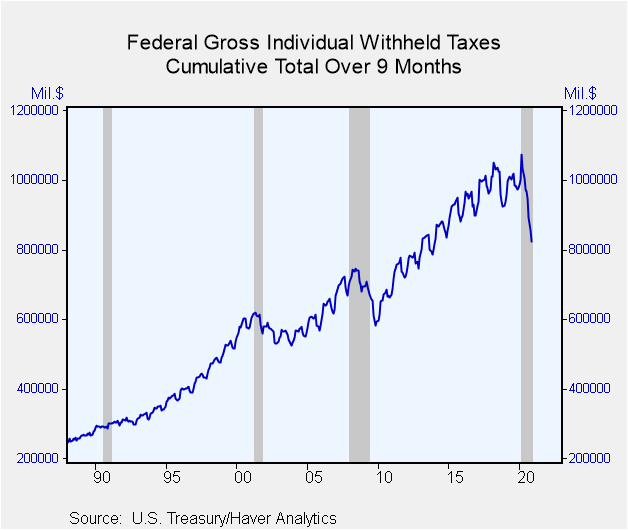 Global| Dec 14 2020
Global| Dec 14 2020Federal Taxes Paint Grim Picture on the Economy: Congress Should Take Notice
|in:Viewpoints
Summary
Data on federal tax receipts paints a grim picture of the state of the US economy. Weak tax receipts are sending a signal of economic distress. Congress needs to act with urgency and pass federal support legislation to help broad [...]
 Data on federal tax receipts paints a grim picture of the state of the US economy. Weak tax receipts are sending a signal of economic distress. Congress needs to act with urgency and pass federal support legislation to help broad parts of the economy.
Data on federal tax receipts paints a grim picture of the state of the US economy. Weak tax receipts are sending a signal of economic distress. Congress needs to act with urgency and pass federal support legislation to help broad parts of the economy.
Federal withheld income tax receipts represent hard contemporaneous data. Tax receipts are current and complete, unlike other economic data series such as household and payroll employment, which are based on a sampling of a small percentage of the working population and businesses.
The pandemic hit the economy in March, triggering widespread job loss and partial and full closing of many small businesses. In November, 9 months into the pandemic, federal gross withheld income tax receipts were off 13% from a year ago. That is roughly in line with the average decline of 15% recorded over the 9-month span, March through November.
Checking the tax data records from the US Treasury the decline in tax receipts over the last 9 months is the largest on record. The only comparable period is the 14% drop in 2009 during the Great Financial Recession.
But the decline in withheld tax receipts in 2009 was in part driven by the tax cuts passed by Congress. A report by the Congressional Budget Office (CBO) found that the 2009 decline in tax receipts consisted of a sharp drop in household income, especially among the top 1 percent earners, and through a reduction in withholding taxes. Recall in 2009, finance, a sector that employs a lot of the top-wage earners lost a record 300,000 jobs, and those that kept their jobs saw a sharp reduction in pay and bonuses.
In 2020 Congress did not pass any tax cut, and top-wage earners, especially in finance, have seen increases in jobs and income. So the record decline in federal income tax receipts in 2020 is of a different ilk.
It's too early to ascertain the main source of the tax receipt collapse in 2020. But I would be willing to bet that in addition to the income loss associated with job loss in travel, entertainment, and recreation, a big chunk is also due to the income losses incurred by small businesses.
According to the National Federal of Businesses of Independent Businesses, 75% of small firms operate as "unincorporated pass-through entities. That means the small business owners pay the personal tax rate, which is calculated on the business owners total earnings. So taxes paid by small businesses show up alongside workers taxes in federal withheld income tax receipts. That probably helps explain the gap between the 15% decline in tax receipts over the past 9 months and the 7% decline in employment.
Congress has been negotiating for several months a second federal stimulus package. But political fighting over the scale and who gets support and who doesn't has so far stymied a bi-partisan deal. I don't support big government, but the federal government is supposed to step up during a crisis.
Taxes are sending an S.O.S signal, saying that significant parts of the economy are experiencing severe distress. Anyone in Congress that is on the fence over whether a second stimulus bill is necessary needs to look no further than the tax data.
Investors have been patient, banking on Congress to build a bridge of fiscal support until medical science develops a vaccine. Medical science has done its job, but Congress has not. If Congress doesn't act soon the speculative gains in the equity markets could quickly reverse in scale.
Viewpoint commentaries are the opinions of the author and do not reflect the views of Haver Analytics.Joseph G. Carson
AuthorMore in Author Profile »Joseph G. Carson, Former Director of Global Economic Research, Alliance Bernstein. Joseph G. Carson joined Alliance Bernstein in 2001. He oversaw the Economic Analysis team for Alliance Bernstein Fixed Income and has primary responsibility for the economic and interest-rate analysis of the US. Previously, Carson was chief economist of the Americas for UBS Warburg, where he was primarily responsible for forecasting the US economy and interest rates. From 1996 to 1999, he was chief US economist at Deutsche Bank. While there, Carson was named to the Institutional Investor All-Star Team for Fixed Income and ranked as one of Best Analysts and Economists by The Global Investor Fixed Income Survey. He began his professional career in 1977 as a staff economist for the chief economist’s office in the US Department of Commerce, where he was designated the department’s representative at the Council on Wage and Price Stability during President Carter’s voluntary wage and price guidelines program. In 1979, Carson joined General Motors as an analyst. He held a variety of roles at GM, including chief forecaster for North America and chief analyst in charge of production recommendations for the Truck Group. From 1981 to 1986, Carson served as vice president and senior economist for the Capital Markets Economics Group at Merrill Lynch. In 1986, he joined Chemical Bank; he later became its chief economist. From 1992 to 1996, Carson served as chief economist at Dean Witter, where he sat on the investment-policy and stock-selection committees. He received his BA and MA from Youngstown State University and did his PhD coursework at George Washington University. Honorary Doctorate Degree, Business Administration Youngstown State University 2016. Location: New York.


